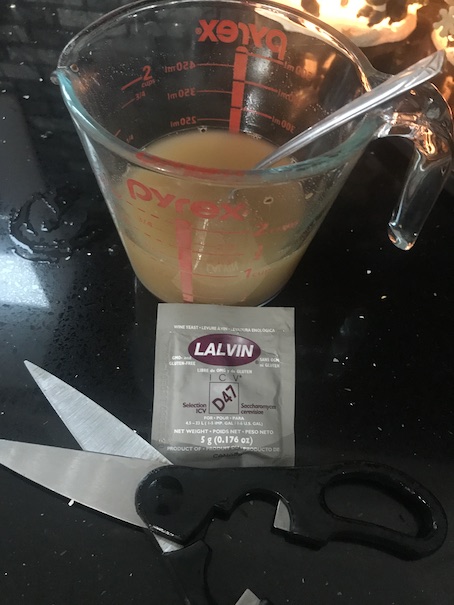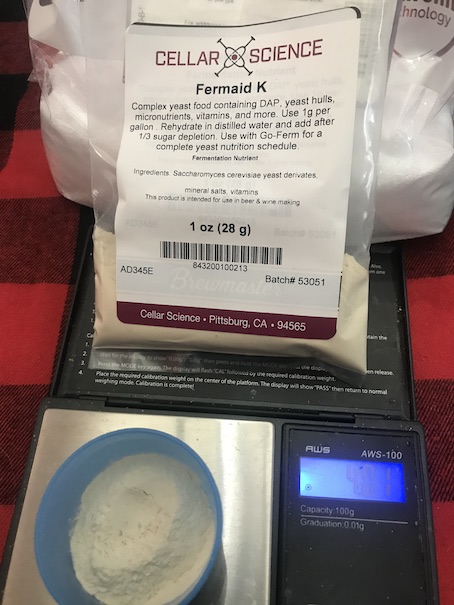Let’s talk about this easy to make cyser! It is as easy as “dump and stir” .. Well kinda.
First off, ‘What is a cyser?’
– A cyser is a variant of a mead.
Now you ask, ‘What is a mead?’
– A mead is a beverage created by fermenting honey with water. The world’s oldest alcoholic drink and generally called the drink of the Gods! It’s is like beer and not like beer; it’s like wine and not like wine. It is it’s own distinct category and has been around millenia!
Click here to see the info: So a cyser, is a mead, that is a blend of honey and apple juice and then fermented together. Let’s talk about honey. And next is apple juice or apple cider. And last thing that’s important is yeast. So there you have your main ingredients: Honey, Apple Juice and Yeast. Now we are going to be adding; water, some sugar and yeast nutrients .. but these are optional. So lets see the recipe first: This is for a 5 gallon/19 liter batch size Ingredients: Now Step by Step with Pictures! Start with your store bought apple juice and honey. Since my honey had crystalized some at the top I chose to heat the honey up in a hot water bath. I aimed for the water bath starting at a temperate of ~125ºF which normalized to about 100º after 5 minutes. Now the honey itself probably reached 85º to 90º tops – Heating well aid the honey to pour easily from the container. Be sure NOT to heat the honey up too high because it could change the flavor and not needed at all. As the honey is warming up be sure the sanitize your fermentation vessel and other equipment (like spoon, scissors, airlock, etc.) Sanitizing IS the most important step … Do NOT skip proper sanitization! With the cyser I’m using a bucket since I will be degassing in the next couple days. Degassing is gentle agitating of the must to help get the CO2 out of the fermenting solution. This is done by shaking or stirring Stirring with the using of a wine whip or sanitized spoon works just fine. After sanitizing add you apple juice, or cider, first into the fermenter. I took a gravity reading of the initial apple juice and just like before in the past store bought apple juice is typically a gravity of 1.045. Then adding your honey next. To give you idea adding (1) 40oz / 2.5lbs jug of honey raised the gravity to 1.098! After adding both jugs of honey (totaling 5 lbs) start adding water (1/2) gallon at a time. Stirring thoroughly to incorporate the apple juice and honey to each other. Now moving to the yeast. Rehydrating dry yeast is a simple step and helps it to give it a good start. And with this I’m using Go-Ferm as well with rehydration. First start by heating 1 cup of water to approximately 100ºF. Adding 1-1/2tsp of G0-Ferm and stirring until dissolved. Let sit about 5/10mins. Ensure the water is under 100ºF sprinkle the dry D-47 yeast on top of the Go-Ferm slurry. Now the addition of DAP and FermAid-K. I also will be doing a Staggered Nutrient Addition (SNA) during the fermentation. This is something typical mead makers utilize. Now add your airlock and allow to ferment. Typical room temperature is fine but try to stay within the yeast temperature range, which for D-47 is 60-68°F – I’m controlling the ferment temp at 64ºF Ferment your cyser until reaching finishing gravity and is stable. Typically 2 to 3 weeks is when you can take gravity readings. Then bottle still, keg and force carbonate or in this case I might be back sweetening and bottling. I’ll be back sweetening by first adding 7-1/2 tsp of potassium sorbate for the 5 gallon batch (1/2tsp per gallon), let sorbate sit for 1 week. Then adding back sugar (honey or apple juice concentrate) in small increments, thoroughly stirring and then testing until the desired sweetness. Then proceed to bottling. The sorbate will inhibit the yeast from fermenting the addition of new sugars. Never back sweeten a wine, cider, mead or cyser and bottling with out adding sorbate – Skipping this step will be explosive … no really bottle bombs are no joke! Now hopefully your cyser will be your next go to drink! And drink it like a Norse God!
So lets start with that … Honey and Apple Juice.
Now we can on and on about honey but we’re talking about ‘Easy to Make Cyser’ so store bought honey is what we’re using here. Typically clover honey is what you’ll find in the stores. Sometimes you’ll find wildflower honey and maybe even orange blossom. What you are looking for are the words in honey like: “pure”, “100%”, “raw” or “unpasteurized”. If the honey is “pasteurized” or “filtered” this is fine, this usually means the the natural wild yeast has been killed off and done to slow down the crystallization. But it needs to be honey.
Watch out for the honey that comes in a little bear … this usually is “fake honey” and mainly is sugar, cornstarch and artificial sweeteners. A good test for honey is this: Place a few drops of the honey on a paper towel. If it is honey, it will stay solid and not soak through. If it’s not honey it will wet the paper towel and soak through the paper towel.
Again we’re looking for easy so we’re using store bought juice, or fresh cider from the store. Be sure that it is “100% juice.” It can be pasteurized, it can have ascorbic acid or vitamin C which is commonly added to store bought apple juice. This will not harm the fermentation. Just be sure it has no preservatives at all this will not all the juice to ferment.
Brands like Tree Top, Mott’s or house store brand – whatever you can find that doesn’t have any preservatives (specifically sorbets). Potassium sorbate is a growth inhibitor for yeast and will not allow the yeast to grow and ultimately ferment the juice.
With the batch I chose Lalvin D-47 – which is a white wine yeast. You want a yeast that will leave some body and sweetness after fermentation. A champagne yeast will ferment down to bone dry and leave no body or sweetness behind. Unless this is what you are going for. Depending on your starting gravity and estimated alcohol you can use beer ale yeast as well. But I’d recommend sticking to wine yeasts like: D-47 or 71B for the best results.
OG = 1.060 (What I was targeting)
FG = 1.000 (Estimated)
Est. ABV = 7.8%
Optional ingredients which I’ll be using:
(If desired for cider to kill off wild yeast and if you’re using tap water to rid you of chlorine and chloramine)
(A natural yeast rehydration nutrient added to the yeast hydration water)
Staggered Nutrient Adds (SNA) – See below
(A yeast energizer)
(A yeast nutrient)
Possible additions at the end – Again these are OPTIONAL as well


I’m using StarSan, you can also use other sanitizes like OneStep, IOStar or Iodophor.

After adding 2 gallons of water the gravity was at 1.079. Now this is a optional step I added 12oz [or 3/4 lbs] of brown sugar and ended up adding 3.25 gallons of water reaching just under 5 gallons and an original gravity of 1.060. This was is my desired starting point for my cyser.


And let sit until yeast starts to show activity. About 20mins total time for rehydration process.



I’ll be using a modified technique that Ken Schramm made famous. Which is:
When degassing and adding nutrients, do it slowly to avoid rapid foaming



